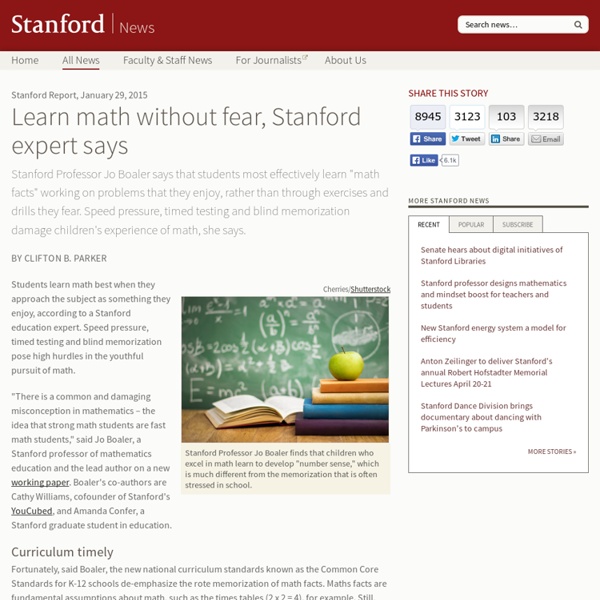Learn math without fear, Stanford expert says

FluencyWithoutFear-Jan-28-2015.pdf
Helping Children Make Sense of Numbers: Number Sense | Dr. Rebecca Palacios
Number sense is one of the most difficult concepts to teach young children. Why? Because it's abstract. For children to grasp number sense, they need to understand that an abstract symbol (the number 3 or 8, for example) means an amount or quantity that could apply to anything. They need to learn that the number 7 can stand for the girls in the room, cups in a box, blocks on a table, pieces of a puzzle or how many scrapes they have on their leg. But once children develop number sense, wow! Young learners love knowing that numbers can represent everything from a single, little pebble in the palm of their hand to the billions of grains of sand on a beach. To teach number sense to your young child, begin with the numbers 1 to 10 because we use a base 10 system, and these are the numbers that young learners are most familiar with. Here are some of the many simple activities that can help your child to develop number sense: Talk about numbers--what they mean to you and how you use them.
How to Count: A Guide for Grownups | The Kids' Quadrant
One of the things I love about my job is that I get to look in-depth at mathematics concepts that appear basic, but are surprisingly complex. Understanding the complexity of the skills our kids are learning can really help us as parents to appreciate what they are capable of. Knowing what we’re watching can also change how we interact with our children. Take counting. Counting is second-nature to us grownups and we probably can’t even remember when it wasn’t. But it takes children several years of practice and play to become really, truly proficient. Learn all the counting words (“one, two, three, four, …”).Remember the correct order for all the counting words.Make sure every single thing in the set gets counted. That’s a lot of stuff! Counting Before You Know How Not long ago I recorded my nephew counting cookie dough blobs on a cookie sheet. Notice that my nephew uses the correct counting sequence through ten, but then skips straight to 14 and 16. See? ENCOURAGE: Count everything!
8 ways teachers can talk less and get kids talking more
If you do fewer teacher-directed activities, that means the kids will naturally do more talking, doesn’t it? Not necessarily. I have often found myself talking almost constantly during group work and student-directed projects because I’m trying to push kids’ thinking, provide feedback, and help them stay on task. Even when the learning has been turned over to the students, it’s still tempting to spend too much time giving directions, repeating important information, and telling students how they did instead of asking them to reflect on their work. 1. It can be uncomfortable to watch kids struggle to figure out an answer, but they need time and silence to work through it. 2. It’s easy to get in an instructional rut when you stand at the same place near the board all day long. 3. Cut down on conversations about bathroom/water/pencil sharpening/etc by teaching kids to use sign language to request permission: use sign language to indicate your answer back: yes, no, or wait. 4. 5. 6. 7. 8.
5 steps to a problem-solving classroom culture
Math problems can be engaging and thought-provoking with the right instructional strategies Problem solving is one of today’s top skills—students who apply problem-solving strategies in the classroom are building important talents for college and the workforce. The math classroom is one of the best places to help students build these skills. Creating a culture of problem solving in a math classroom or in a school involves prompting students and educators to think a little differently and systemically. “The world does not need more people who are good at math,” said Gerald Aungst, supervisor of gifted and elementary mathematics in Pennsylvania’s Cheltenhamn Township Schools. “What the world needs are more problem solvers and more innovators.” “We want people who are innovators, and don’t assume that what people tell them is impossible is impossible,” Aungst said during an edWeb leadership webinar. (Next page: Five steps to creating a culture of problem solving)
Related:
Related:



